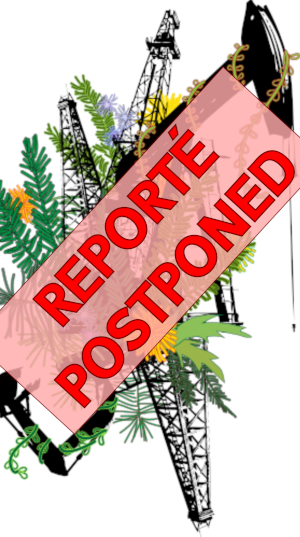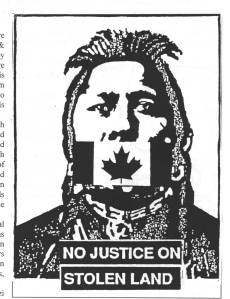Indigenous Struggles / Luttes autochtones
Day of workshops: Ecology, anticapitalism and resistance
Day of workshops: Ecology, anticapitalism and resistance

Given the current situation, the day of workshops "Ecology, anticapitalism and resistance" planned for Saturday, March 28th at the SCPA is postponed to a future date. The date will be announced when it gets clearer what this future has in store for us.
Event Teach-ins/Conférences
ᑲᐦᑭᔭᐤ ᑭᐋᐧᐦᑯᐦᑐᓇᐤ
ᑲᐦᑭᔭᐤ ᑭᐋᐧᐦᑯᐦᑐᓇᐤ

I remember the first time I killed a deer. I don’t know why, but before we started skinning or anything, I walked up to that deer and I put my hand on it. I could feel that the deer was still warm. In that moment I knew that he was the same as me. As I had taken his life, now I owed him mine.
Journal Article Heatstroke! (2020)
Antiracist and Anticapitalist Contingent at the Climate Strike March
Antiracist and Anticapitalist Contingent at the Climate Strike March

The fight against climate change must break out of its rut. It must also fight the system of borders which benefits certain lives more than others. It must crush this capitalist economy which is always looking to produce more, more and more. It must fight the migrant prison being built in Laval, in which children are raised behind bars. It must fight imperialism which forces countries of the South to produce for a pittance what we consume here in the North. It must fight white supremacy, whether it takes the form of neo-fascist militia, conservative talking heads, or colonial governments which impose their law on unceded native lands. It must fight those who benefit from poisoning the Earth and from the exploitation of our sisters and brothers.
Event Contingents
July 1st, 2017 - Anticolonial and Anti-imperial Protest
July 1st, 2017 - Anticolonial and Anti-imperial Protest

150 years of colonialism is nothing to celebrate!
Anti-colonial and anti-imperialist demonstration in Montreal on July 1st, 2017
Time and place soon to be announced!
Mark your calendars!
Call out for an anti-colonial anti-Canada day everywhere in Canada in 2017
Call out for an anti-colonial anti-Canada day everywhere in Canada in 2017

Hi!
We're reaching out to allied groups and individuals all over so-called “Canada” because we want to organize an anti-colonial Anti-Canada day on July 1st in Montreal. We'd like to propose you do the same in your city, to have demonstrations, events, disruptions and anti-colonial actions all across Canada.
Another world is possible... if we destroy capitalism!
Another world is possible... if we destroy capitalism!

Meet up at Place Pasteur, St-Denis street (between Ste-Catherine and Maisonneuve), on Thursday, August 11th, at 6PM!
Because, for the first time ever, the World Social Forum takes place in North America. This is an historic opportunity to see another side of modern capitalism: instead of seeing the poverty and exploitation of the Southern states, the attendees will be able to observe the wealth and decadence of the North.
Press Release
Protest against COP21 - Let's stop the pyro-firefighters!
Protest against COP21 - Let's stop the pyro-firefighters!

Protest in response to the « COP21 » Paris climate conference
Wednesday, December 4th, 2015
6:30PM
Norman Bethune Square
(Guy-Concordia metro station)
A copresentation of CKUT
Anticolonial - Anticapitaliste
Anticolonial - Anticapitaliste
Le capitalisme sur ce continent a commencé dès la colonisation génocidaire des peuples autochtones et la dépossession de leurs territoires par les État-nations européens, principalement la France et l'Angleterre. L'objectif principal de cette colonisation était de contrôler le territoire pour en extraire les ressources naturelles et y établir des colonies. Par ce processus de colonisation, les hommes européens en position de pouvoir ont répandu leur société patriarcale, chrétienne et militaire au sein de ce qui est maintenant devenu un système global.
Autodétermination(s) contre la répression de l'État --- Résistance autochtone contre les oléoducs à bitume (Ligne 9/Energy East) ---
Autodétermination(s) contre la répression de l'État --- Résistance autochtone contre les oléoducs à bitume (Ligne 9/Energy East) ---
Manifestons contre le Plan Nord (8 février)
Manifestons contre le Plan Nord (8 février)
À l’occasion du Salon des ressources naturelles au Palais des congrès de Montréal ...
MANIFESTONS CONTRE LE PLAN NORD
VENDREDI LE 8 FÉVRIER, 12h
RASSEMBLEMENT: Square Victoria (métro Square Victoria)
[facebook: https://www.facebook.com/events/124816917688020/]
(Cette manifestation est endossé par la Convergence des luttes anticapitalistes (CLAC) de Montréal. Nous encourageons nos alliéEs et sympathisantEs à participer à la manifestation en grand nombre.)
Demonstrate against the Plan Nord (February 8)
Demonstrate against the Plan Nord (February 8)
Coinciding with the: Forum on Natural Resources at the Palais des congrès in Montreal ...
DEMONSTRATE AGAINST THE “PLAN NORD”
FRIDAY, FEBRUARY 8, 12pm
GATHERING: Square Victoria (métro Square Victoria)
[facebook: https://www.facebook.com/events/124816917688020/]
Defending the Land: Indigenous Women’s resistance to Plan Nord and community violence
Defending the Land: Indigenous Women’s resistance to Plan Nord and community violence

Innu women speak out about the Plan Nord and violence against their communities. Activists will discuss their opposition to the massive industrial development plan being imposed on them by the government. They will speak about the impacts of the new infrastructure development north of the 49th parallel and its devastating cultural and environmental implications.
Event will be in French with simultaneous translation to English. Événement aura lieu en français avec traduction simultanée en anglais. Wheelchair accessible, and childcare available with 48 hours notice. Presented by the 2110 Centre for Gender Advocacy's Missing Justice campaign (Justice for Missing and Murdered Indigenous Women) in collaboration with Regroupement de solidarité avec les Autochtones, Alliance Romaine, PASC and the Anti-Colonial Solidarity Collective.
With guest speakers Denise Jourdain, Élyse Vollant and Ellen Gabriel :
ANTI-COLONIAL FORUM AGAINST THE PLAN NORD For a sharing of resistance to Plan Nord and Colonization
ANTI-COLONIAL FORUM AGAINST THE PLAN NORD For a sharing of resistance to Plan Nord and Colonization

When: Saturday the 29th of September, 10 am-5 pm
Where: the 7th floor of Hall, at Concordia University, 1455 boulevard de Maisonneuve West
The event will take place in two stages: a panel on Friday evening with indigenous women involved in resistance to colonialism, followed by an open forum on Saturday for sharing our strategies, with workshops and spaces for discussion. If you already have a workshop you would like to present on Saturday, you will be able to propose it during the open forum. The forum will serve to verbalize our paths of sharing and discussion, on an anti-capitalist and anti-colonial basis.
WarriorPublications.com Statement on RBC Arson Attack
WarriorPublications.com Statement on RBC Arson Attack
http://www.warriorpublications.com/?q=node/112
May 21, 2010
Occupied Coast Salish Territory
[Vancouver, Canada]
The May 18, 2010, arson attack on the Royal Bank of Canada in Ottawa was clearly an anti-colonial and anti-capitalist action. It has had a strong impact across the country and invoked the wrath of the state. As both sabotage and propaganda, the attack was highly successful: the bank was almost totally destroyed while the RBC's funding of the genocidal Tar Sands was once again highlighted.
Press Release



